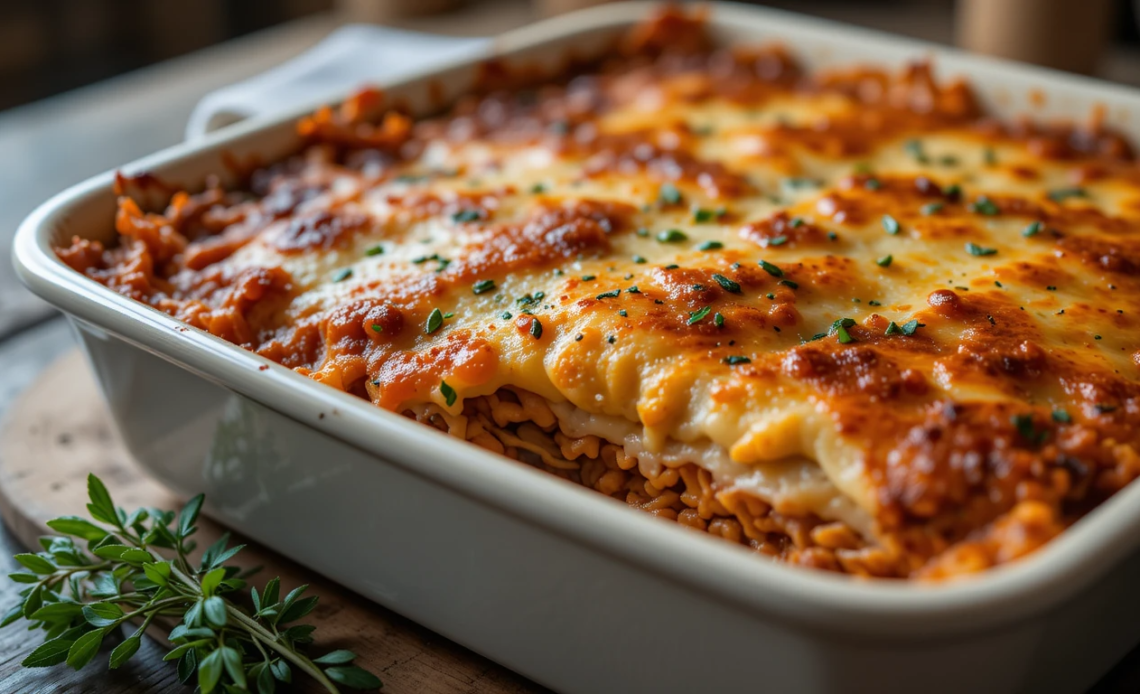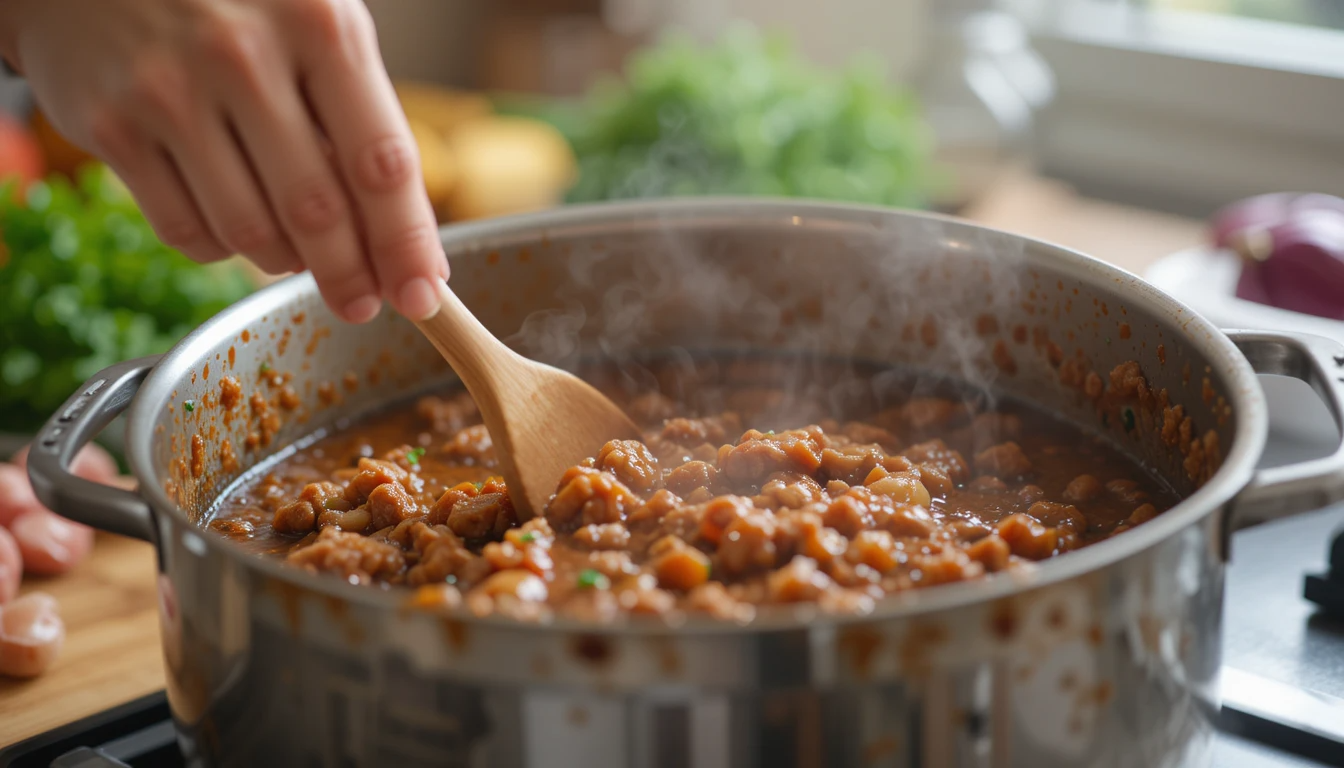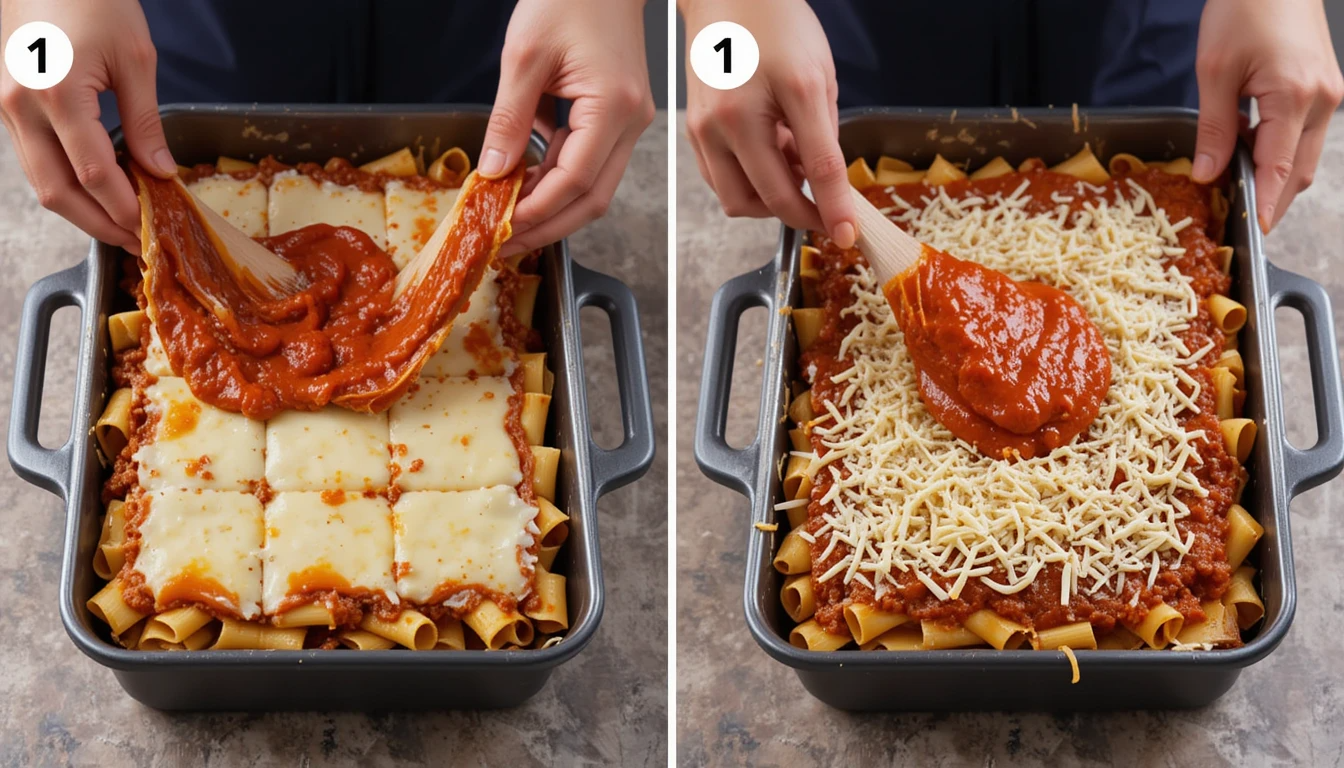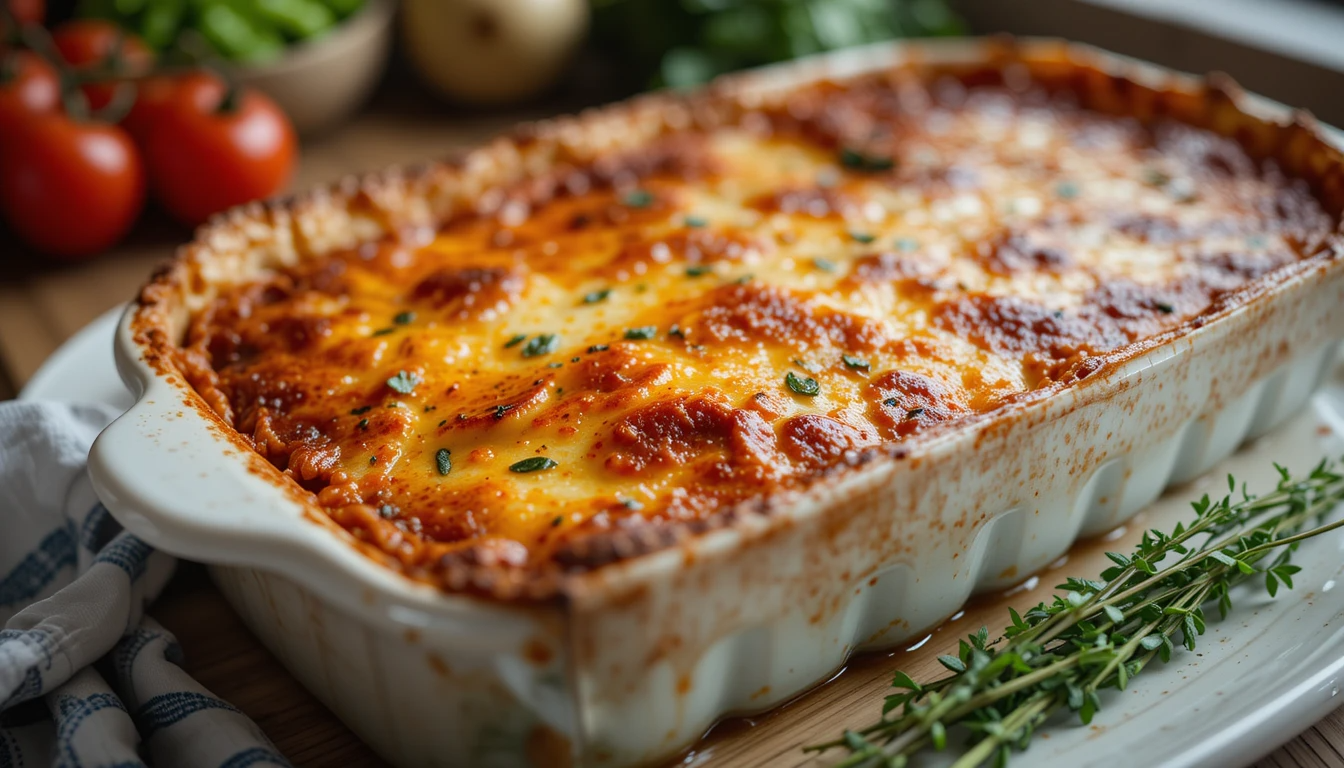
Table of Contents
What Makes Lasagna So Popular?
Lasagna Recipe Lasagna is more than just a dish—it’s an experience. In many households, lasagna is a cherished meal, often prepared for family gatherings, holidays, or special occasions.
I have fond memories of making lasagna with my mom, who would prepare the dish in layers, carefully assembling each ingredient with love and precision.
It wasn’t just about the flavors but the tradition of cooking and sharing something homemade. Over time, lasagna has gained a global reputation as the quintessential comfort food.
Whether in Italy, the United States, or any other part of the world, people enjoy lasagna because of its warm, hearty nature, which provides both satisfaction and nostalgia. The melting cheese, savory sauce, and tender noodles come together in a way that’s truly irresistible.
Why You Should Try Making Homemade Lasagna
The beauty of homemade lasagna lies in its ability to be tailored to your tastes. Unlike store-bought options, which often lack the depth of flavor and freshness, a homemade lasagna recipe allows you to control every aspect. You can choose your preferred meat, sauce, and cheese, ensuring the perfect combination that suits your taste buds. Making lasagna from scratch also guarantees a superior texture. The noodles are cooked to perfection, the layers are impeccably arranged, and the flavors meld together wonderfully. Additionally, preparing lasagna at home offers a sense of accomplishment and connection with tradition, as you create something hearty and nourishing from scratch.

The Secret to a Perfect Lasagna
The Key Ingredients for a Flavorful Lasagna
When it comes to making the best lasagna, the secret lies in the quality and balance of the ingredients. I have always believed that the foundation of any great lasagna is a rich, flavorful sauce. It starts with high-quality ground meat, whether it’s beef, pork, or a combination of both. The meat is browned and simmered with tomatoes, onions, garlic, and herbs to create a savory sauce that coats the pasta perfectly. A little bit of sugar can balance out the acidity of the tomatoes, and the addition of red wine or vinegar can bring depth to the sauce, giving it complexity and richness.
The cheeses you use also play a crucial role. Ricotta, mozzarella, and Parmesan are the classic trio, but the ratio of these cheeses can affect the texture and flavor. I’ve always preferred a slightly higher ratio of mozzarella to ricotta, creating a creamy, melty texture that complements the savory sauce beautifully.
Choosing the Best Lasagna Noodles
The choice of lasagna noodles is another key factor. You can opt for traditional, regular lasagna noodles, which need to be boiled before assembling, or you can go with no-boil noodles, which save time. If you’re using traditional noodles, it’s essential to ensure they don’t overcook; they should be tender but not mushy. For no-boil noodles, ensure your sauce is sufficiently liquid to allow the noodles to cook properly in the oven. Both types have their merits, but the right noodle can make or break the dish.
Part 3: Essential Lasagna Recipe Ingredients
Ground Meat or Meat Alternatives
The choice of meat is fundamental to achieving a great lasagna. Traditionally, ground beef is the preferred option, providing a hearty base for the sauce. However, I’ve discovered that combining ground beef with ground pork or Italian sausage adds layers of flavor that elevate the entire dish. If you prefer a lighter version, ground turkey can also be an excellent alternative, offering a leaner option without sacrificing the texture or flavor. For vegetarians or those looking to explore different variations, using plant-based proteins or vegetables such as mushrooms and spinach can still provide a rich, savory flavor without the meat.
Cheese Choices for Lasagna
Cheese is the heart of lasagna. Ricotta cheese offers a smooth, creamy texture that balances the other ingredients beautifully. Mozzarella, on the other hand, is key for creating that gooey, melted layer of cheese that everyone loves. I always opt for whole milk mozzarella for its creamy consistency. And don’t forget Parmesan—its sharp, nutty flavor enhances the richness of the sauce and cheese mixture. Some variations include adding mascarpone for a creamier texture or using fontina for a more robust flavor.
Tomato Sauce and Herbs (H3)
The sauce is arguably one of the most critical components of lasagna. For a traditional lasagna recipe, you’ll need a rich tomato-based sauce, which is typically made by simmering crushed tomatoes, tomato paste, garlic, onions, and herbs. Basil, oregano, and thyme are the classic herbs used to give the sauce its aromatic depth. Adding a touch of red wine or balsamic vinegar enhances the acidity and balances the sweetness of the tomatoes. I’ve found that allowing the sauce to simmer for at least an hour ensures that the flavors meld and intensify.
The Step-by-Step Process for Making Lasagna

Step 1: Preparing the Meat Sauce
The first step in creating the perfect lasagna is preparing the meat sauce. I begin by browning the ground meat in a large skillet, ensuring it’s broken up into small pieces. Once the meat is browned, I add finely chopped onions and garlic, sautéing them until they’re fragrant and soft. Then, I incorporate the tomato paste, crushed tomatoes, and a splash of red wine (if desired). The sauce is seasoned with salt, pepper, oregano, basil, and a pinch of sugar to balance out the acidity. The key here is to let the sauce simmer for at least 45 minutes, allowing the flavors to meld together.
Step 2: Preparing the Noodles and Cheese Mixture
While the sauce is simmering, I cook the lasagna noodles in a large pot of salted boiling water. If I’m using traditional noodles, I ensure they’re al dente to avoid overcooking them during the baking process. If using no-boil noodles, I ensure that my sauce is adequately liquid to help them soften during baking. In a separate bowl, I mix the ricotta cheese with an egg, Parmesan, and some fresh chopped herbs. The mixture should be smooth and spreadable, creating a creamy layer between the noodles.
Step 3: Assembling the Lasagna
Once the sauce and cheese mixture are prepared, I start layering the lasagna in a 9×13-inch baking dish. First, I spread a thin layer of sauce at the bottom to prevent sticking. Then, I add the first layer of noodles, followed by a generous portion of meat sauce, and a layer of cheese mixture. I repeat this process, building the layers until I’ve used up all the ingredients. I finish with a final layer of noodles, sauce, and cheese, ensuring that the top layer has a generous amount of cheese for that golden, bubbly finish.
Step 4: Baking and Final Touches
I cover the lasagna with aluminum foil to prevent it from drying out while baking, and place it in a preheated 350°F oven. After 30 minutes, I remove the foil and let the lasagna bake for an additional 15-20 minutes until the top is golden and bubbly. Once out of the oven, I let the lasagna rest for 10-15 minutes before cutting it. This resting time allows the layers to set, ensuring that the lasagna holds together when served.
What is the Correct Order to Layer Lasagna?
Layering the Ingredients in the Right Order
When assembling lasagna, the order of the layers is crucial to achieving a well-structured dish. I always start with a thin layer of sauce at the bottom of the baking dish to prevent the noodles from sticking. Then, I add the first layer of lasagna noodles. On top of the noodles, I spread a layer of meat sauce, followed by a layer of cheese mixture. This process is repeated for each subsequent layer, ensuring that each layer of noodles is fully covered by sauce and cheese. The final layer should be noodles, followed by sauce and a generous amount of cheese to create a golden, bubbly top.
Tips for Ensuring the Best Layers
For perfect lasagna, it’s essential to avoid overloading the layers with too much sauce or cheese, as this can lead to a soggy dish. I’ve found that evenly distributing the sauce and cheese helps prevent clumping and ensures each bite is balanced. It’s also important to use fresh, properly cooked noodles. For a smooth texture, I make sure the sauce is thick enough to support the noodles without making them soggy. These small details can make a big difference in the final result.
How to Customize Your Lasagna Recipe
Adding Vegetables to Lasagna
One of the best things about lasagna is how versatile it is. Over the years, I’ve enjoyed experimenting with different vegetable fillings. For example, I add spinach, zucchini, or mushrooms for an added depth of flavor and texture. Sautéing vegetables like mushrooms helps release their moisture and prevents the lasagna from becoming too watery. Adding vegetables not only enhances the flavor but also boosts the nutritional value, making it a hearty, wholesome meal.
Meat Variations for Lasagna
While traditional lasagna often uses ground beef or pork, there are plenty of variations to explore. In my experience, using ground turkey or chicken offers a leaner alternative without sacrificing the rich, savory flavor. Additionally, incorporating Italian sausage can add a nice kick and depth of flavor. For those seeking plant-based options, tofu or lentils can provide a satisfying substitute for meat.
Spicing Up Your Lasagna
If you enjoy bold flavors, consider adding a pinch of red pepper flakes or fresh basil for a bit of spice. I also love experimenting with garlic and onions, which bring out the natural sweetness of the tomatoes. You can also add a touch of nutmeg to the cheese mixture for a subtle warmth that complements the other ingredients.
Common Mistakes to Avoid When Making Lasagna

Overcooking or Undercooking the Noodles
One of the most common mistakes when making lasagna is overcooking or undercooking the noodles. I recommend cooking traditional lasagna noodles until they are al dente, as they will continue to cook in the oven. For no-boil noodles, ensure your sauce has enough moisture to cook the noodles properly during baking. It’s essential to avoid soggy noodles, as they can ruin the texture of the lasagna.
Too Much Sauce or Cheese
Another pitfall is using too much sauce or cheese. While both ingredients are key to a great lasagna, it’s crucial to balance the quantities to avoid a soggy, greasy dish. I recommend spreading the sauce and cheese evenly between the layers, making sure not to overload any one layer. The key is to use enough to create a flavorful dish, but not so much that it overwhelms the other ingredients.
FAQs
What is the secret to a good lasagna?
The secret to a good lasagna recipe lies in the quality and balance of ingredients. The meat sauce should be rich and flavorful, made with high-quality ground meat, ripe tomatoes, and fresh herbs. The cheese mixture should be creamy but not too heavy, with ricotta, mozzarella, and Parmesan as the base. Another key element is the noodles. Whether using traditional or no-boil noodles, they should be cooked just right to ensure that the lasagna holds its shape without becoming soggy. The layering process is also crucial—ensuring that the sauce, cheese, and noodles are evenly distributed leads to a perfectly cooked lasagna.
What ingredients do I need for lasagna?
For a classic lasagna recipe, you will need the following ingredients:
- Ground meat (beef, pork, or a combination)
- Tomato sauce (crushed tomatoes or tomato paste)
- Ricotta cheese
- Mozzarella cheese
- Parmesan cheese
- Lasagna noodles (either regular or no-boil)
- Egg (to bind the ricotta cheese)
- Fresh herbs (basil, oregano)
- Garlic and onion (for added flavor)
- Olive oil (for sautéing)
- Sugar and red wine vinegar (to balance the sauce)
These ingredients come together to form a delicious lasagna. You can customize the filling with extra vegetables or different meat options depending on your preference.
What is the correct order to layer lasagna?
The correct order to layer lasagna is essential for achieving a perfectly cooked dish. Start by spreading a thin layer of sauce at the bottom of the baking dish to prevent sticking. Next, add a layer of noodles, followed by a generous layer of meat sauce. Then, spread a layer of the cheese mixture (ricotta, mozzarella, and Parmesan) over the sauce. Repeat the process, ensuring that each layer is evenly distributed. The final layer should consist of noodles, followed by sauce and a generous amount of cheese. This order ensures that the lasagna is rich in flavor, with each bite containing a perfect balance of pasta, sauce, and cheese.
What to put in a lasagne?
A traditional lasagna typically includes layers of meat sauce, pasta, and cheese. However, there are numerous variations to suit different preferences:
- Vegetables: You can add spinach, mushrooms, zucchini, or even eggplant for extra flavor and nutrients.
- Meat: Ground beef is the most common choice, but you can also use ground pork, Italian sausage, or ground turkey for a lighter version.
- Cheese: Ricotta, mozzarella, and Parmesan are the staples, but you can add mascarpone for a creamier texture or fontina for a richer flavor.
- Herbs and spices: Fresh basil, oregano, and a pinch of nutmeg can enhance the flavor of your lasagna.
- Non-traditional ingredients: For a twist, try adding seafood, pesto, or bacon to your lasagna.
This versatility allows you to create a lasagna that is perfectly tailored to your tastes.
